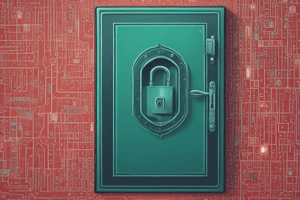Podcast
Questions and Answers
What are the three primary components of the CIA Triad in Information Security?
What are the three primary components of the CIA Triad in Information Security?
- Confidentiality, Integrity, Availability (correct)
- Control, Integrity, Availability
- Confidentiality, Intrusion, Availability
- Confidentiality, Integrity, Authorization
What is the primary purpose of 'RAID' technology in data storage?
What is the primary purpose of 'RAID' technology in data storage?
Data redundancy, performance improvement, or both
A stateful firewall only allows traffic that is part of a new or already established connection, while a packet filtering firewall examines the content of the traffic.
A stateful firewall only allows traffic that is part of a new or already established connection, while a packet filtering firewall examines the content of the traffic.
False (B)
What is the main goal of using a 'fuzzer' in security testing?
What is the main goal of using a 'fuzzer' in security testing?
The Gramm-Leach-Bliley Act (GLBA) focuses on protecting the privacy of customers' non-public personal information.
The Gramm-Leach-Bliley Act (GLBA) focuses on protecting the privacy of customers' non-public personal information.
A brute force attack involves the use of multiple password attempts until the correct one is guessed.
A brute force attack involves the use of multiple password attempts until the correct one is guessed.
The HIPAA law specifically governs the protection of information related to educational institutions.
The HIPAA law specifically governs the protection of information related to educational institutions.
Which component of the Parkerian Hexad is specifically concerned with the ownership or creator attribution of data?
Which component of the Parkerian Hexad is specifically concerned with the ownership or creator attribution of data?
In the context of attack types, which term describes an event that causes data to become unavailable or unusable?
In the context of attack types, which term describes an event that causes data to become unavailable or unusable?
What is the correct order of steps in the risk management process?
What is the correct order of steps in the risk management process?
Which type of authentication involves verifying a user based on their geographical location?
Which type of authentication involves verifying a user based on their geographical location?
What process includes preparation activities performed before an incident occurs?
What process includes preparation activities performed before an incident occurs?
Which of the following best defines a 'threat' in information security?
Which of the following best defines a 'threat' in information security?
In mutual authentication, what is typically exchanged to verify each party?
In mutual authentication, what is typically exchanged to verify each party?
What is the primary objective of the containment process in incident management?
What is the primary objective of the containment process in incident management?
Which act aims to promote the adoption of electronic health records by healthcare providers?
Which act aims to promote the adoption of electronic health records by healthcare providers?
Which access control model allows the system administrator to define access based on predetermined rules?
Which access control model allows the system administrator to define access based on predetermined rules?
What is the primary purpose of compliance in an organizational context?
What is the primary purpose of compliance in an organizational context?
What does the principle of 'least privilege' aim to achieve in access control?
What does the principle of 'least privilege' aim to achieve in access control?
In the context of access control, what does revoking access entail?
In the context of access control, what does revoking access entail?
Which of the following describes the term 'phishing' in cybersecurity?
Which of the following describes the term 'phishing' in cybersecurity?
What does the term 'defense in-depth' refer to in security?
What does the term 'defense in-depth' refer to in security?
What is the main focus of post-incident activity in incident management?
What is the main focus of post-incident activity in incident management?
Which of the following is NOT a form of access control?
Which of the following is NOT a form of access control?
What kind of measures does a Network Intrusion Detection System (NIDS) specifically focus on?
What kind of measures does a Network Intrusion Detection System (NIDS) specifically focus on?
Which access control model gives the owner of the resources the authority to determine who gets access?
Which access control model gives the owner of the resources the authority to determine who gets access?
What is a primary responsibility of accountability in access control?
What is a primary responsibility of accountability in access control?
Which term refers to measures taken to eliminate the effects of a security incident?
Which term refers to measures taken to eliminate the effects of a security incident?
What can be concluded about the confidentiality provided by hash functions?
What can be concluded about the confidentiality provided by hash functions?
Which statement best describes digital signatures?
Which statement best describes digital signatures?
What is the purpose of certificates in cryptography?
What is the purpose of certificates in cryptography?
What differentiates data at rest from data in motion?
What differentiates data at rest from data in motion?
Which encryption method is the hardest to implement effectively?
Which encryption method is the hardest to implement effectively?
What is a common characteristic of a DDoS attack?
What is a common characteristic of a DDoS attack?
What is the role of IPsec in network security?
What is the role of IPsec in network security?
Which of the following statements is true regarding keyless cryptography?
Which of the following statements is true regarding keyless cryptography?
How does the Family Educational Rights and Privacy Act (FERPA) protect individuals?
How does the Family Educational Rights and Privacy Act (FERPA) protect individuals?
What distinguishes a man-in-the-middle attack from other cyber attacks?
What distinguishes a man-in-the-middle attack from other cyber attacks?
Which of the following best describes nonrepudiation?
Which of the following best describes nonrepudiation?
What distinguishes an Intrusion Prevention System (IPS) from an Intrusion Detection System (IDS)?
What distinguishes an Intrusion Prevention System (IPS) from an Intrusion Detection System (IDS)?
Which of the following describes symmetric cryptography?
Which of the following describes symmetric cryptography?
Which of the following is NOT a characteristic of Block Ciphers?
Which of the following is NOT a characteristic of Block Ciphers?
Which of the following symmetric key algorithms is considered outdated and insecure?
Which of the following symmetric key algorithms is considered outdated and insecure?
What is the primary function of Asymmetric Cryptography?
What is the primary function of Asymmetric Cryptography?
Which of the following protocols is primarily known for securing web and email traffic?
Which of the following protocols is primarily known for securing web and email traffic?
What key length options does AES support?
What key length options does AES support?
What is the main purpose of SSL and TLS protocols?
What is the main purpose of SSL and TLS protocols?
Penetration testing is most accurately defined as?
Penetration testing is most accurately defined as?
Flashcards
CIA Triad
CIA Triad
A model of information security focusing on Confidentiality, Integrity, and Availability.
Confidentiality
Confidentiality
Ensuring only authorized individuals access data.
Integrity
Integrity
Maintaining data accuracy and preventing unauthorized changes.
Availability
Availability
Signup and view all the flashcards
Parkerian Hexad
Parkerian Hexad
Signup and view all the flashcards
Threat
Threat
Signup and view all the flashcards
Vulnerability
Vulnerability
Signup and view all the flashcards
Authentication
Authentication
Signup and view all the flashcards
Mutual Authentication
Mutual Authentication
Signup and view all the flashcards
Risk Management Process
Risk Management Process
Signup and view all the flashcards
Incident Response Process
Incident Response Process
Signup and view all the flashcards
Authorization
Authorization
Signup and view all the flashcards
Least Privilege
Least Privilege
Signup and view all the flashcards
Access Control
Access Control
Signup and view all the flashcards
Network ACL
Network ACL
Signup and view all the flashcards
Accountability
Accountability
Signup and view all the flashcards
Intrusion Detection (IDS)
Intrusion Detection (IDS)
Signup and view all the flashcards
Intrusion Prevention (IPS)
Intrusion Prevention (IPS)
Signup and view all the flashcards
Symmetric Encryption
Symmetric Encryption
Signup and view all the flashcards
Asymmetric Encryption
Asymmetric Encryption
Signup and view all the flashcards
Phishing
Phishing
Signup and view all the flashcards
Tailgating
Tailgating
Signup and view all the flashcards
Brute Force
Brute Force
Signup and view all the flashcards
Buffer Overflow
Buffer Overflow
Signup and view all the flashcards
SQL Injection
SQL Injection
Signup and view all the flashcards
Cross-Site Scripting (XSS)
Cross-Site Scripting (XSS)
Signup and view all the flashcards
Discretionary Access Control (DAC)
Discretionary Access Control (DAC)
Signup and view all the flashcards
Mandatory Access Control (MAC)
Mandatory Access Control (MAC)
Signup and view all the flashcards
Role-Based Access Control (RBAC)
Role-Based Access Control (RBAC)
Signup and view all the flashcards
What are the three main principles of the CIA Triad?
What are the three main principles of the CIA Triad?
Signup and view all the flashcards
What's a major difference between the CIA Triad and the Parkerian Hexad?
What's a major difference between the CIA Triad and the Parkerian Hexad?
Signup and view all the flashcards
Interception Attack
Interception Attack
Signup and view all the flashcards
What's a Vulnerability?
What's a Vulnerability?
Signup and view all the flashcards
What is the purpose of Mutual Authentication?
What is the purpose of Mutual Authentication?
Signup and view all the flashcards
Why is Risk Management Important?
Why is Risk Management Important?
Signup and view all the flashcards
What is an Incident Response Process?
What is an Incident Response Process?
Signup and view all the flashcards
HIPAA
HIPAA
Signup and view all the flashcards
HITECH Act
HITECH Act
Signup and view all the flashcards
SOX Act
SOX Act
Signup and view all the flashcards
GLBA
GLBA
Signup and view all the flashcards
PCI DSS
PCI DSS
Signup and view all the flashcards
Nonrepudiation
Nonrepudiation
Signup and view all the flashcards
Intrusion Detection System (IDS)
Intrusion Detection System (IDS)
Signup and view all the flashcards
Intrusion Prevention System (IPS)
Intrusion Prevention System (IPS)
Signup and view all the flashcards
Auditing
Auditing
Signup and view all the flashcards
Penetration Testing
Penetration Testing
Signup and view all the flashcards
Cryptography
Cryptography
Signup and view all the flashcards
Symmetric Cryptography
Symmetric Cryptography
Signup and view all the flashcards
Asymmetric Cryptography
Asymmetric Cryptography
Signup and view all the flashcards
SSL (Secure Sockets Layer) and TLS (Transport Layer Security)
SSL (Secure Sockets Layer) and TLS (Transport Layer Security)
Signup and view all the flashcards
What is the difference between IDS and IPS?
What is the difference between IDS and IPS?
Signup and view all the flashcards
Hash Function
Hash Function
Signup and view all the flashcards
Keyless Cryptography
Keyless Cryptography
Signup and view all the flashcards
Digital Signature
Digital Signature
Signup and view all the flashcards
Certificate
Certificate
Signup and view all the flashcards
IPsec and SSL VPN
IPsec and SSL VPN
Signup and view all the flashcards
Protecting Data at Rest
Protecting Data at Rest
Signup and view all the flashcards
Protecting Data in Motion
Protecting Data in Motion
Signup and view all the flashcards
Protecting Data in Use
Protecting Data in Use
Signup and view all the flashcards
DDOS Attack
DDOS Attack
Signup and view all the flashcards
Man-in-the-Middle Attack
Man-in-the-Middle Attack
Signup and view all the flashcards
Study Notes
Fundamentals of Information Security
- CIA Triad: Confidentiality (only authorized access), Integrity (data unaltered), Availability (accessible when needed).
- Parkerian Hexad: Confidentiality (authorized access), Integrity (unaltered without detection), Availability (accessible when needed), Possession (physical control of data), Authenticity (correct origin), Utility (usefulness of data).
- Attack Types: Interception (affects confidentiality), Interruption (unavailable assets), Modification (tampering), Fabrication (false information).
Key Concepts, Identification, and Authorization
-
Authorization: Defining what a user can access, modify, and delete.
-
Least Privilege: Granting users only the minimum access required for their job.
-
Access Control: Allowing, denying, limiting, and revoking access to resources.
-
Access Control Models: Discretionary (DAC), Mandatory (MAC), Role-based (RBAC), Attribute-based (ABAC). Explains each by defining the entity that controls access, and what guides the process of resource access.
-
Accountability: Tracking actions for responsibility.
-
Nonrepudiation: Preventing denial of actions or statements
Access Control
- Access Control List (ACL): Rules for permission on network traffic.
Auditing, Cryptography, and Legal Issues
-
Cryptography: Using codes and ciphers for secure information.
- Symmetric Cryptography: Uses a single key to encrypt and decrypt.
- Block Cipher: Encrypts fixed-size blocks of data.
- Stream Cipher: Encrypts data one bit at a time.
- Asymmetric Cryptography: Uses a public and private key.
- Secure Sockets Layer (SSL), Transport Layer Security (TLS): Protocols securing data transmission.
- Symmetric Cryptography: Uses a single key to encrypt and decrypt.
-
Hash Functions: Create unique hash values from data.
- Hashes provide integrity (not confidentiality) useful for verifying data integrity. Keyless cryptographic methods relying on mathematical algorithms to secure information.- Keyless Cryptography: Uses mathematical algorithms for security without a key.
-
Digital Signatures: Ensure message authenticity and prevent denial of sending.
-
Certificates: Link a public key to a specific entity, for electronic identification.
-
IPsec and SSL VPN: Technologies securing connections between devices.
Operations and Human Element Study
- Pretexting: Convincing someone by impersonation.
- Phishing: Tricking users with deceptive emails or websites.
- Tailgating: Following an authorized person into a secure area.
- Brute Force: Repeatedly trying passwords until correct.
Physical and Network Security
-
Physical Threats: Extreme temperatures, gases, liquids, living organisms, projectiles, movement, energy, people, toxins, and smoke or fire.
-
Defense-in-Depth: Using multiple security layers for protection.
-
RAID: Data storage technology improving redundancy, performance, and improvement.
-
Intrusive Detection System (IDS): Monitors networks, hosts, or applications for unauthorized activity.
-
Network Intrusion Detection System (NIDS): Detects malicious network activity.
-
Anti-Threat Software & Hosts: Includes firewalls, anti-virus, and spyware detection.
-
Network Segmentation: Dividing a network into smaller, more manageable units.
Protecting data at rest and in motion.
- Data Protection at Rest: Encrypting data stored in a resting state.
- Data Protection in Motion: Encrypting data during transmission.
- SSL/TLS & DDOS Attacks: used in networks.
Laws and Regulations
- FISMA (Federal Information Security Modernization Act): Protecting government information.
- FERPA (Family Educational Rights and Privacy Act): Protecting student information.
- HIPAA (Health Insurance Portability and Accountability Act): Protecting health information.
- HITECH Act: Promoting health information technology adoption.
- SOX (Sarbanes-Oxley Act): Financial records are accurate and timely revealed.
- COPPA (Children's Online Privacy Protection Act): Protecting child data.
- Gramm-Leach-Bliley Act (GLBA): Protecting customer information.
- PCI DSS (Payment Card Industry Data Security Standard): Protecting credit card information.
Operating System and Application Security
- OS Hardening: Reducing vulnerabilities through software removal, altering accounts, and timely updates.
- Nessus: Vulnerability assessment tool identifying and assessing system vulnerabilities.
- Buffer Overflows: Exploits insufficient data validation.
- Race Conditions: Vulnerabilities where multiple processes access shared resources simultaneously.
Penetration Testing
- Penetration Testing: Mimicking real-world attack methodologies in controlled environments.
Network Tools for Security
- Firewalls: Controlling network traffic flow.
- Packet Filtering: Allowing or blocking specified traffic types.
- Stateful Firewalls: Monitoring connection states.
- Deep Packet Inspection: Analyzing packet content.
- Proxy Servers: Filtering traffic and serving as intermediaries.
- DMZ (Demilitarized Zone): Separating internet-reachable services from the internal network.
- Port Scanners (Nmap): Identifying open ports on a system.
- Packet Sniffers (Wireshark, Tcpdump): Analyzing network traffic.
- Honeypots: Systems designed to attract hackers and monitor their activities without affecting the safety of the main system.
Additional Security Tools
- SQL injections and XSS (Cross-Site Scripting): Security vulnerabilities.
- Fuzzers (Nikto or Wireshark): Security testing methodology.
Studying That Suits You
Use AI to generate personalized quizzes and flashcards to suit your learning preferences.
Related Documents
Description
Test your understanding of essential concepts in information security, including the CIA Triad and the Parkerian Hexad. Explore key elements such as authorization, access control models, and types of attacks. This quiz will challenge your knowledge on how to protect and manage data effectively.




